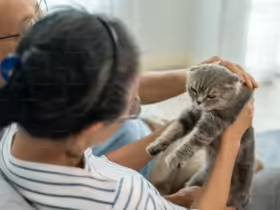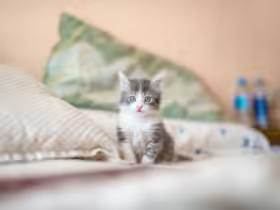Contents
What to Do If Your Cat Has Diarrhea: A Comprehensive Guide
Diarrhea in cats is a common issue that can arise from various causes. While it might seem like a minor inconvenience, it can sometimes signal more serious health problems. Understanding the causes of diarrhea, recognizing the signs, and knowing how to respond appropriately is crucial for your cat’s well-being. In this blog, we’ll cover everything you need to know about handling feline diarrhea, including symptoms, potential causes, treatment options, and preventive measures.
Recognizing Diarrhea in Cats
Diarrhea is characterized by loose, watery stools that occur more frequently than usual. Here are some signs to look for:
- Changes in Stool Consistency
The most apparent sign is a change in stool consistency. Normal cat stools should be firm and well-formed. Diarrhea presents as liquid or semi-liquid stools. - Increased Frequency
If your cat is using the litter box more frequently or having accidents outside the box, it could be a sign of diarrhea. - Presence of Blood or Mucus
Look out for blood or mucus in your cat’s stool. While a small amount of blood can be relatively benign, significant bleeding or mucus can indicate a more serious problem. - Vomiting
Diarrhea often accompanies vomiting. If both symptoms are present, it could point to a gastrointestinal issue. - Loss of Appetite and Lethargy
A cat with diarrhea may eat less or appear lethargic due to discomfort or dehydration. - Dehydration
Diarrhea can cause dehydration, which might be evident through dry gums, a sunken appearance of the eyes, or decreased skin elasticity.
Potential Causes of Diarrhea in Cats
Diarrhea can be caused by a variety of factors, including:
- Dietary Changes
Sudden changes in diet or introducing new foods can upset your cat’s digestive system. This includes switching brands of cat food, adding table scraps, or giving treats. - Food Intolerances and Allergies
Some cats are sensitive to certain ingredients in their food. Food intolerances or allergies can lead to gastrointestinal upset and diarrhea. - Infections
Bacterial, viral, or parasitic infections can cause diarrhea. Common culprits include Salmonella, E. coli, and parasites like Giardia and Coccidia. - Toxins
Ingesting toxic substances such as plants, chemicals, or human medications can lead to diarrhea. If you suspect your cat has ingested something harmful, contact your vet immediately. - Stress
Changes in environment or routine, such as moving to a new home or the addition of a new pet, can stress your cat and result in gastrointestinal issues. - Underlying Health Conditions
Chronic conditions such as inflammatory bowel disease (IBD), hyperthyroidism, or liver disease can cause persistent diarrhea. - Medications
Some medications, including antibiotics, can disrupt the balance of bacteria in the gut, leading to diarrhea.
Immediate Steps to Take
- Monitor Your Cat
Observe your cat’s condition closely. Keep track of the frequency and consistency of the diarrhea, and note any additional symptoms such as vomiting or lethargy. - Ensure Hydration
Diarrhea can quickly lead to dehydration. Make sure your cat has constant access to fresh water. You might also offer an electrolyte solution designed for pets if recommended by your vet. - Fasting
Withhold food for 12 to 24 hours to allow your cat’s digestive system to rest. After this period, reintroduce food gradually with a bland diet. - Reintroduce Food Gradually
When reintroducing food, start with a bland diet such as boiled chicken (no skin or bones) and plain rice or a special prescription diet recommended by your vet. Avoid dairy and high-fat foods during this period. - Clean Up
Keep your cat’s litter box clean and monitor the environment for cleanliness to reduce the risk of further gastrointestinal upset. - Consult Your Veterinarian
If diarrhea persists for more than 24-48 hours, or if you notice additional symptoms such as blood in the stool, vomiting, or signs of dehydration, contact your veterinarian.
Veterinary Evaluation and Treatment
- Diagnostic Tests
Your vet may perform a physical examination and recommend diagnostic tests such as fecal exams, blood work, or imaging studies to determine the underlying cause of the diarrhea. - Medications
Treatment may include medications to address infections, parasites, or inflammatory conditions. Your vet might prescribe antibiotics, anti-parasitic drugs, or anti-inflammatory medications based on the diagnosis. - Special Diets
If food intolerance or allergies are suspected, your vet may recommend a hypoallergenic or prescription diet to manage your cat’s condition. - Treatment of Underlying Conditions
If diarrhea is related to an underlying health condition, treating that condition is crucial. Your vet will provide a treatment plan specific to the diagnosed condition.
Preventing Diarrhea in Cats
- Gradual Diet Changes
When switching cat food, do so gradually over a period of 7-10 days to minimize digestive upset. Mix the new food with the old food, gradually increasing the proportion of the new food. - Regular Vet Check-ups
Routine veterinary visits can help catch and manage underlying health conditions before they cause serious problems. - Maintain a Clean Environment
Keep your cat’s living environment clean to prevent exposure to toxins or harmful substances. Regularly clean the litter box and ensure your cat does not have access to toxic plants or chemicals. - Manage Stress
Reduce stress by maintaining a stable environment and providing enrichment activities for your cat. Gradual introductions of new pets or changes in routine can help minimize stress-related gastrointestinal issues. - Monitor for Allergies
Be aware of any potential food allergies or intolerances your cat may have. Choose high-quality cat food with easily digestible ingredients and avoid giving table scraps.











Leave a Reply